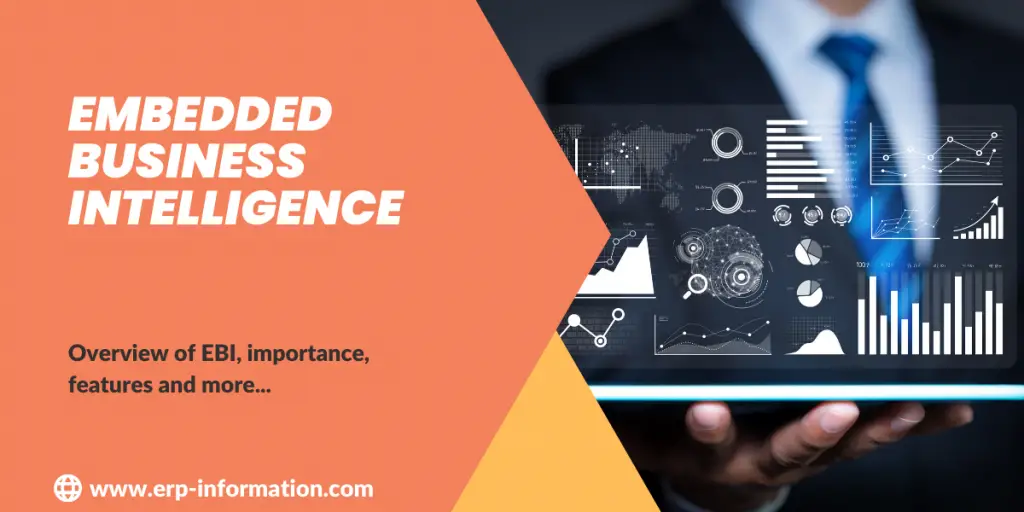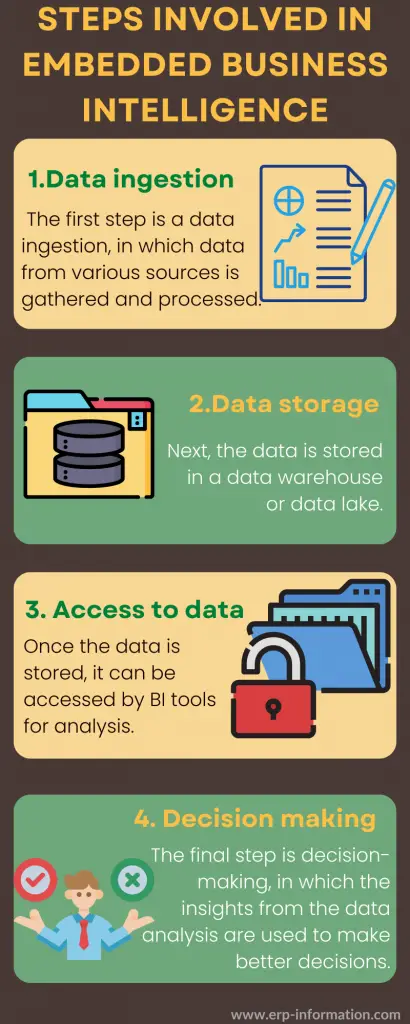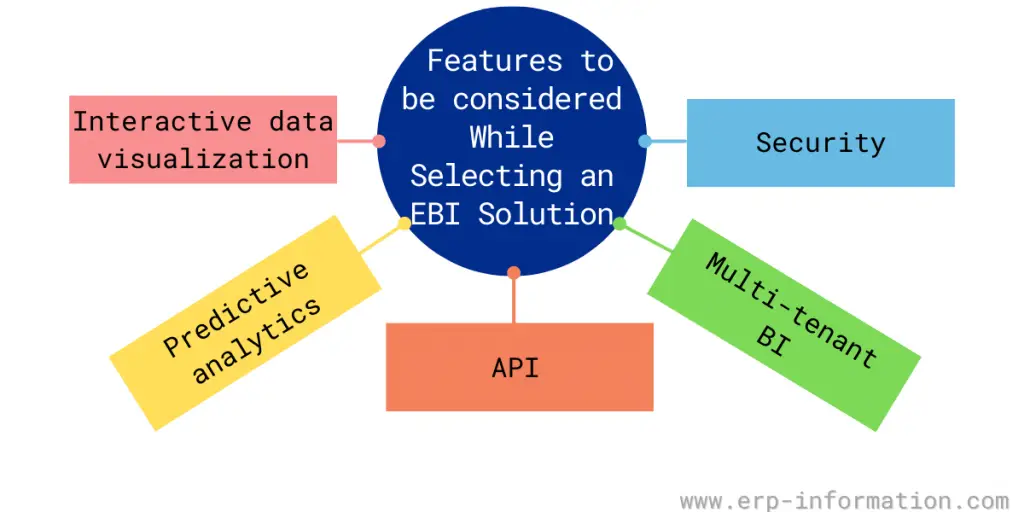As the data businesses collect increases, the need for practical business intelligence tools becomes more critical.
Business intelligence (BI) tools help organizations make sense of all the data they collect by providing features like data visualization, reporting, and analytics.
Embedded business intelligence (EBI) is a type of business intelligence tightly integrated into end-user applications and business data sources.
What is embedded business intelligence?
Traditionally, BI tools have been stand-alone applications accessed by users through a web interface. However, a new trend is emerging in business intelligence. That is embedded business intelligence.
Embedded Business Intelligence is a BI solution embedded directly into an organization’s existing applications and systems. That means business users don’t have to leave their current application to access BI features like interactive dashboards, data visualization, reporting, predictive analytics, etc.
Instead, they can stay within the application they’re already using, and the BI features will be integrated into the interface.
Main reasons to use Embedded Business Intelligence
- Embedded BI can help you make decisions based on data.
- It makes it easier to work with data.
- Embedded BI also allows you to quickly change and update your decisions.
Steps involved in embedded business intelligence
A general overview of Embedded BI includes the following steps:
- Data ingestion: The first step is data ingestion, in which data from various sources is gathered and processed.
- Data storage: Next, the data is stored in a data warehouse or data lake.
- Access to data: Once the data is stored, it can be accessed by BI tools for analysis.
- Decision making: The final step is the data analysis’s insights are used to make better decisions.
Why is embedded BI essential?
- Embedded business intelligence (BI) is the next step in the evolution of BI, and it is essential for any organization that wants to stay ahead of the competition.
- Embedded BI is a type of BI embedded into another application, such as a CRM system or an e-commerce platform. That lets users access BI tools and data directly from their application without switching to a separate BI platform.
- That is important because users can get the necessary information without logging in to a separate system.
- It also makes it easier for organizations to adopt BI, as they can add it to their existing applications rather than build a separate BI platform from scratch.
What features to consider while selecting an EBI solution?
The main functions you need to consider while choosing the best EBI solution for your business include.
- Interactive data visualization – Look for an EBI solution that offers interactive data visualization, so you can explore your data differently and find the data insights you need.
- Predictive analytics – Choose an EBI solution that offers predictive analytics features, so you can identify trends and foresee future events.
- API – Look for an EBI solution that offers a robust API to connect to the data and applications you need easily.
- Multi-tenant BI – If multiple users need to access the BI solution, ensure that the EBI solution you choose offers multi-tenant BI. This way, each user can have their account and access the needed data.
- Security – Choose an EBI solution that offers security features like user authentication and data encryption to ensure your data is safe.
Along with the above features, you should consider some more important features like Flexible deployment options, Scalability, Affordability, and Customer support while selecting Embedded Business Intelligence.
Now that you know the main features to look for in an EBI solution, it’s time to choose one best meets your needs.
Benefits
Embedded BI has many benefits, but the five most important ones are listed below.
User-friendly interface
The data visualization feature in EBI allows a User-friendly interface and customizable dashboards to see their data more meaningfully to understand it better.
Interactive dashboards provide users with a visual representation of their data and customized data, and they also allow users to see how data changes over time. That also helps to better data management within the organization.
Increased adoption of BI
One of the most significant benefits of embedded BI is that it leads to increased adoption of BI within an organization.
That is because embedded BI makes it easier for users to access BI software and data. In addition, users can access BI features within their application without switching to a separate BI platform.
That makes it more likely that users will use BI software, as they are not faced with the barrier of learning a new system.
Data-driven decision making
Another significant benefit of embedded BI is that it leads to better decision-making.
Since everyone can access data with embedded BI, regardless of experience or skill level, embedding analytics gives fast access to data that enables better and more intelligent decision-making.
Enables self-service reporting
Embedded BI also leads to increased self-service reporting.
Self-service reporting is when users can access BI tools and data without going through IT. That enables users to personalize their business applications and access, analyze, and act on data without relying on IT or data analysts. That gives the best user experience.
Improve efficiency and productivity
With embedded BI, you can also automate your workflow.
When data visualization and analytics solutions are embedded within your business applications, you can use them automatically to generate reports or take action based on data.
For example, you can use embedded BI to automatically generate a report when a sales goal is met or send an alert when inventory levels are low.
This can help to improve efficiency and productivity within your organization.
Challenges of Embedded Business Intelligence
While embedded BI offers many benefits, it also comes with its own set of challenges. Here are some common challenges that organizations may face when implementing embedded BI:
Integration complexity
Integrating embedded BI into a software application can be complex, especially if the application has a complex data structure or architecture. This can result in longer development cycles and higher implementation costs.
Limited data sources
Embedded BI is typically limited to the data within the specific software application it is integrated with, which may not provide a comprehensive view of the organization’s data. This can restrict the insights and analytics derived from the data.
Data quality issues
The accuracy and consistency of the data within the software application may be inconsistent or contain errors, which can impact the accuracy of the insights provided by embedded BI.
User adoption
While embedded BI is designed to be user-friendly, non-technical users may struggle to understand how to use the tools and access the insights they need. This can result in low user adoption rates and underutilization of the embedded BI tools.
Customization challenges
Customizing embedded BI to fit the needs of the specific software application can be difficult, especially if the software application is highly customized or has unique data requirements.
Security and privacy concerns
Embedded Business Intelligence may present security and privacy concerns, especially if integrated with sensitive or confidential data. Organizations must ensure appropriate security measures are in place to protect data and comply with regulatory requirements.
Difference between Embedded Business Intelligence and traditional Business Intelligence
| Difference | Embedded BI | Traditional BI |
| Integration | It is integrated directly into a software application, such as a CRM or ERP system, and seamlessly integrated into the application workflow, allowing users to access insights and analytics without leaving the application. | It typically pulls data from multiple sources to comprehensively view the organization. |
| Userbase | It is designed for non-technical users who need access to data and insights to make informed decisions. | It is designed for data analysts and business intelligence professionals skilled in data analysis and visualization. |
| Customization | It is highly customizable to fit the needs of the specific application it is integrated with. | While traditional BI requires customization to fit the organization’s needs. |
| Datasource | It focuses on the data within the specific software application. | It typically pulls data from multiple sources to provide a comprehensive view of the organization. |
| Cost | Embedded BI is often less expensive than traditional BI since it is built into an existing application. | Traditional BI requires purchasing and implementing a standalone software application. |
List of embedded Business Intelligence tools
- Bold BI
- MicroStrategy
- Tableau
- QlikView
- Tableau
- Oracle BI
- SAS Visual Analytics
- TIBCO Spotfire
- Good data
- Domo
FAQs
What is an example of embedded business intelligence?
A touch screen is an example of embedded BI that connects different products, systems, or services. This connection happens through wires, radio signals, light, or other communication methods such as sound or smell.
What data type is used for embedded?
Embedded C can use three types of numbers: int, short, and long. Usually, on 8-bit computers, the int values are 16 bits. But Embedded C lets you change int sizes to 8 or 16 bits to save space in memory.
Conclusion
Embedded Business Intelligence is quickly becoming the standard for data analysis in businesses. It is because it offers many advantages over traditional business intelligence, including increased adoption, data-driven decision-making, self-service reporting, and improved efficiency and productivity.
If you’re looking for an embedded BI solution for your business, consider Bold BI, MicroStrategy, Tableau, QlikView, and Oracle BI.


